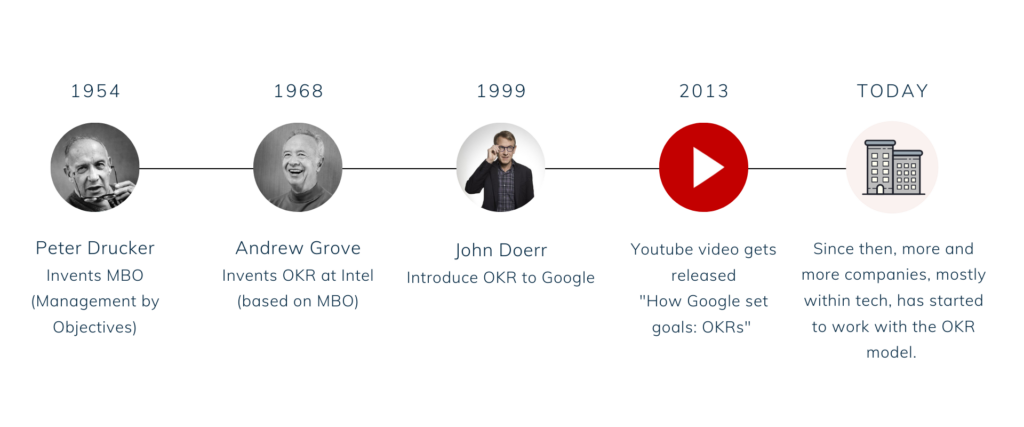The next generation of OKR – OKR 2.0
We at Howwe Technologies love OKR. It’s a methodology that have grown to become highly popular as organizations crave a supportive method for figuring out how to stay aligned and competitive through the disruptions associated with today’s fast-paced business climate. Join us as we dig into the core of OKR while comparing it to Howwe.

The magic with Howwe is found in the combination of our user-friendly software and proven method. Howwe enables a natural culture of commitment for everyone, not only the high-achievers. We call it the Howwe way of working. Some call it OKR’s for the people,
Johan Grönstedt, Chief Product Officer at Howwe Technologies
What are OKRs?
OKR is an acronym for Objectives and Key Results. OKR is a goal-setting framework for defining and tracking objectives and their outcomes, with the purpose of aligning goals and ensuring everyone is working together on the right goals. It’s both a way to structure goals and a goal management methodology where it’s often up to the adopting organization to chose their approach. Many turn to OKR softwares and other use more traditional means of implementing the method.
What are OKRs not?
OKRs should not include all of your organization’s work or track business-as-usual activities. A WorkOS is typically used for this. Duplicating what already excists as tasks or procedures isn’t focusing on what matters.
The 3 key differences between OKRs and Howwe
Howwe and OKR both aim to streamline organizational efforts, focusing on goal achievement amid a flurry of activities. These methods guide managers and teams in setting and executing strategic goals, offering clarity, focus, alignment, and engagement. They are easy to learn and lead to enhanced execution.
While both support strategic execution theoretically, Howwe stands out in practice. It offers a user-friendly framework, bolstered by automated business support, which has been instrumental in helping hundreds of companies translate their strategies into tangible results. Howwe’s approach is proven to effectively meet strategic goals, requiring commitment across the organization.
Key 1
The Acceleration Meeting
Acceleration meetings, held weekly, focus on transparency and accountability, enhancing long-term execution. These brief meetings review Key Activity results and strategize towards the Most Important Goal. They bolster team engagement and focus, guiding employees towards strategic tasks and away from operational distractions. Here, teams evaluate progress, celebrate successes, and commit to goal-driven actions. Managers also use these sessions to promptly address and correct any misalignments.
Key 2
The Acceleration of Goals
All Howwe customers experience measurable financial improvement and acceleration. This improvement is evident daily, weekly, and annually, starting from an initial business case. Howwe’s combination of method and software sets measurable, actionable goals at every organizational level, directly linked to financial outcomes. In contrast, OKR is often criticized for lacking this direct financial connection and focusing more on the present. Howwe eliminates ambiguity about goal achievement and impact, as it visually tracks and showcases team progress and achievements, boosting confidence at both individual and team levels and significantly enhances employee Net Promoter Score (eNPS).
Key 3
A top-down approach
Howwe’s top-down approach, starting with the CEO’s focus on a few key goals, drives unparalleled results. These prioritized goals cascade through every team, ensuring that achieving them addresses core business issues. This alignment accelerates work and hastens outcomes. Moreover, Howwe’s quick, automated onboarding further speeds up results. Simultaneously, it functions as a bottom-up tool, empowering rapid alignment and high involvement with company-wide goals. This approach boosts commitment and confidence by visually showing individual contributions to these goals.
Is Howwe OKR 2.0?
Yes, according to Gartner’s defition of Howwe that’s correct.
It’s recognized as a new generation of OKR software, enriched with additional features and automated intelligence. Unlike typical OKR tools, Howwe provides individual guidance, insights, and alerts driven by automated intelligence to help achieve set goals. It also aids in goal-setting and activity planning, areas where many struggle. The Howwe Library, unlike freely available OKR examples, contains goals and activities that have been rigorously vetted and proven successful by over 1000 teams.
Howwe not only addresses business problems but also accelerates business processes. It measures this acceleration at the activity level, with a focus on high-quality check-ins and a commitment process. This systematic approach enhances focus and combats goal inflation. Additionally, Howwe facilitates strategic initiative execution, organized and tracked by Sprint Labels. Differing from the bottom-up approach of most OKR software, Howwe begins with top-level engagement, directly involving CEOs to drive enterprise growth.
Every organization is different- choosing the right software for you!
We have looked at what OKR is and compared it to Howwe and the Howwe Way of Working. We’ve concluded that there are many similarities and we know that choosing isn’t always easy. That’s we gathered our 5 cents on the most suitable solution based on your organizations maturity, ambitions and needs.
A method for the average organization and employee
OKRs have been successful among high-achieving individuals and teams, providing flexibility in setting priorities and goals with mutual accountability. However, not every company possesses the high-achiever traits needed for OKR success, as seen in companies like Google. OKRs focus on measuring desired outcomes, but simply measuring them doesn’t guarantee achievement. In contrast, Howwe’s Key Activities effectively guide employees weekly to prioritize tasks, addressing a common challenge in OKRs of managing numerous objectives and results, which can be overwhelming even for high-performing teams.
OKRs can be effective when implemented correctly, but they often lack clarity in objectives and results, leading to inefficiencies. Howwe emphasizes clarity, directing all users to define clear, measurable activities aligned with the organization’s most important goal. Unlike OKRs, which sometimes track individual performance, Howwe starts with the CEO’s primary goals, cascading them through the organization on a team basis. This approach ensures individual commitments align with the team’s contribution to these key goals, fostering collective progress.
A method for the experienced OKR user
For experienced OKR users seeking to enhance their organization’s goal management, Howwe’s method provides a proactive approach, addressing common issues with OKRs like cluttered focus and inadequate measurability and progress tracking. Howwe combines method and software, streamlining data aggregation for insightful, data-driven analysis of past and future performance. It narrows down the number of goals, emphasizing lead measures that drive results. Structured follow-ups in Howwe enhance visibility of progress, fostering accountability and commitment, and enabling managers to make timely adjustments.
Howwe may offer slightly less autonomy for high achievers compared to OKRs, but it equips all teams for success. The tool is essential for organizations serious about goal achievement, enabling them to measure and visually forecast future outcomes based on proven financial results.
History of OKR 1954 – TODAY

A short history of OKR
The history of OKR is around seventy years old. In 1954, Peter Drucker invented the management model ‘Management by Objectives’ (MBO). In 1968 Andrew Grove co-founded Intel Corporation and at the same time furthered developed MBO into the OKR framework as we know it today.
John Doerr joined Intel in 1974 and learned OKR during his time there. In 1999 he introduced OKR to the founders of Google and they were swift to implement the method in the company and making it a part of their DNA. In 2013, Rick Klau covers the value of setting objectives and key results in a Google venture startup lab and the method really takes off. Since then, more and more companies like Adobe, Facebook, and Slack have started working with the OKR model. Today, thousands of companies worldwide have adopted the framework.
What are you waiting for?
Howwe is the Solution for Growth.
With our method and software, we simplify the execution of your strategy.

